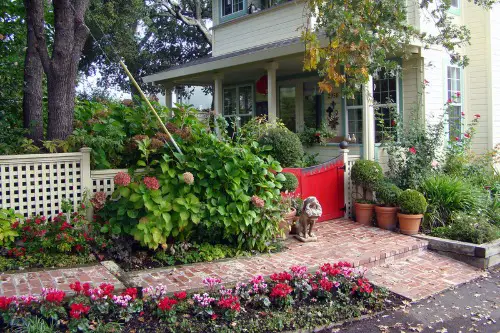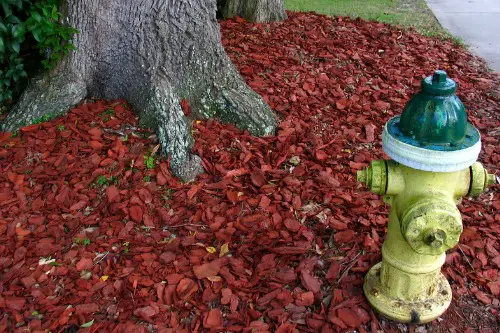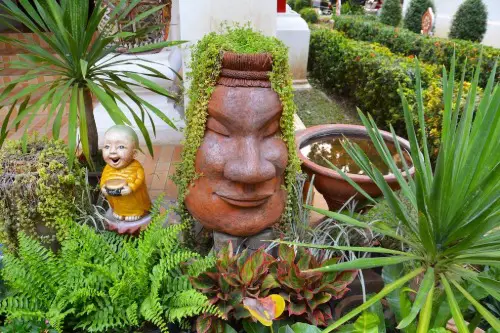1. Fake or Overdone Curb Appeal

Fresh paint and a few flowers are great, but when curb appeal looks too staged, buyers get suspicious. Things like plastic flowers, rented potted plants, or obviously temporary landscaping scream “cover-up.” It can lead buyers to wonder what’s being hidden or what the yard looks like without all the extras. Real, rooted landscaping carries more long-term value and credibility.
Even expensive upgrades—like renting mature trees or elaborate entry planters—can feel fake if they’re not permanent. It’s better to invest in thoughtful, modest improvements than go overboard with temporary flash. Buyers want authenticity, and a yard that looks overly “dressed up” can come across as desperate. Trust that simple, well-maintained landscaping sells better than a photo shoot set.
2. Overly Ornate Fountains

Fountains can seem like a symbol of luxury, but when they’re oversized or overly elaborate, they can feel more like something out of a Vegas casino than a welcoming home. Buyers often see them as high-maintenance and impractical, especially if the style clashes with the home’s architecture. If it’s covered in cherubs, faux gold, or flashy lighting, it might read as tacky rather than tasteful. Plus, any hint of algae or murky water gives the impression that upkeep has been neglected.
Even if you spent thousands on installation, buyers might only see future headaches—like plumbing issues or cleaning costs. Subtle, modern water features blend in better and can offer the same calming effect without becoming the centerpiece. The goal is to accent your home, not compete with it. So if your fountain is stealing the spotlight, it may be time to scale it back.
3. White Gravel Lawns

Gravel instead of grass might seem like a chic, low-maintenance alternative, but it doesn’t always translate that way to potential buyers. White gravel, in particular, can look sterile and harsh against a natural landscape. It also gets dirty quickly, showing every leaf, weed, or footprint, and can heat up uncomfortably in direct sunlight. Rather than looking modern, it can read as unfinished or even industrial.
The cost of hauling and installing gravel can be significant, but many buyers associate it with budget fixes or desert xeriscaping—especially outside the Southwest. Gravel also tends to migrate over time, which means more upkeep than you’d expect. Buyers might worry about weed control or safety if they have kids or elderly relatives. A natural-looking ground cover or native plants can often do the same job without the visual drawbacks.
4. Too Much Hardscaping

Stone patios, concrete walkways, and retaining walls are great in moderation, but too much hardscaping can overwhelm your yard. Buyers often want a balance between usable space and natural beauty. If your entire front or back yard is paved over, it may feel more like a parking lot than a home garden. That cold, uninviting vibe can turn people off immediately.
Hardscaping also reflects heat, which can make outdoor spaces less enjoyable in warmer climates. While it’s durable and low-maintenance, buyers may worry about the cost and hassle of removing or altering it. And if the materials don’t match the style of the home, it can look out of place. Spending a lot doesn’t guarantee appeal—sometimes less is truly more.
5. Bright-Colored Mulch

Red or black mulch might catch the eye, but it often sends the wrong message. These bold colors can clash with surrounding plants and structures, making your landscaping look more like a fast-food franchise than a curated home garden. Natural-colored mulch tends to age better and blends in with most landscapes. When it’s too vibrant, it can feel artificial and cheap.
Some dyed mulches are made from recycled wood and may contain chemicals that aren’t great for your soil or plants. Buyers who garden or know their landscaping will notice. Even though colored mulch can cost more, it often looks less natural. A rich, brown mulch or composted leaf material is a safer bet for broad appeal.
6. Mismatched or Excessive Garden Ornaments

A few tasteful pieces—like a well-placed birdbath or a stone bench—can enhance a yard, but too many ornaments make the space feel cluttered and kitschy. Gnomes, flamingos, lanterns, and wind spinners can be fun, but they quickly veer into novelty territory. Buyers may see them as distractions or assume the home has an “eccentric” vibe. The focus should be on your home and garden, not plastic sculptures.
Ornaments also often reflect personal taste, which won’t always match a buyer’s style. What you see as whimsical, they may see as weird or outdated. And while these items may have cost a pretty penny over time, they can drag down the perceived value of your outdoor space. Streamlining before listing is almost always the better move.
7. High-Maintenance Plantings

Elaborate rose gardens, exotic plants, or sculpted topiary may showcase your gardening skills, but they can intimidate buyers. Many people are looking for outdoor spaces that are easy to maintain, not ones that demand hours of weekly care. If your landscaping looks like it needs a full-time gardener, it may actually be a turn-off. The more complex the setup, the more buyers worry about upkeep.
Even if the plants themselves are expensive, they can still reduce appeal if they look like too much work. Non-native species may also be a concern, especially if they’re not drought-tolerant or pest-resistant in your region. Simpler plantings—like native shrubs or perennial beds—tend to appeal to a broader audience. A lush, manageable garden always wins over one that feels like a chore.
8. Artificial Grass

While synthetic turf has come a long way, it still carries a stigma in residential landscaping. Some buyers see it as a shortcut or a sign that the yard isn’t “real,” even if it’s eco-conscious or allergy-friendly. It often gets hot underfoot, can emit an odd smell in warm weather, and lacks the charm of natural greenery. Especially in regions where real grass thrives, faux lawns can feel out of place.
The irony is that artificial grass can cost more upfront than a sod lawn, but to buyers, it can scream “low effort.” It’s also tough to personalize—flower beds and real turf provide flexibility that synthetic lawns don’t. For some buyers, especially families with kids or pets, it’s a red flag rather than a perk. If you’ve installed it thinking it’s a selling point, it might be worth reconsidering before listing.
This post 8 Landscaping Features That Make Your Home Look Cheap to Buyers (Even If They’re Expensive) was first published on Greenhouse Black.
